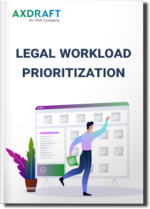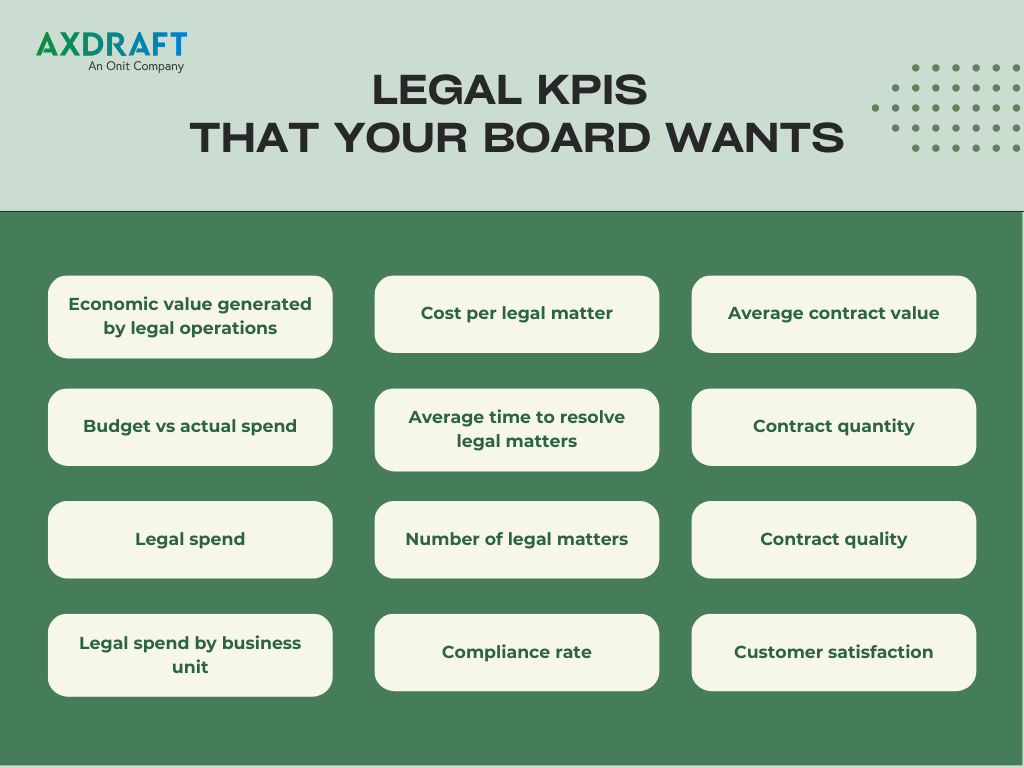Legal is a valuable strategic business partner who is capable of significantly impacting an organization’s performance. That’s why legal departments should be run like a business who sets and analyzes KPIs to measure operations.
At the same time, measuring performance can be a challenge considering that Legal’s functions include ensuring compliance, managing legal risk, and preparing contracts.
You need something concrete if you want to evaluate and present the legal department’s contributions to achieving the company’s goals. But which KPIs will prove a department’s value to executives?
Here we’ll explore common challenges in reaching strategic KPIs, how to overcome them, and which metrics are among the most important. However, these are general indicators that can be built upon and adopted. Chances are high that your workflows have critical KPIs that don’t make this list.
Challenges You May Face (and How to Overcome Them)
Determining an effective KPI can be a challenge as it requires the team’s full attention while business continues as usual. Here are a few difficulties you might encounter along the way:
- Uncertainty about what to measure: If you’ve never tracked KPIs, the first time can be difficult as you might not know where to start. Some professionals get caught up in measuring anything and everything. However, not all bring value. To understand what to measure, you first need to identify why these metrics are important.
- A reluctant team: At times, employees may be resistant to the idea that their productivity will be tracked. In such cases, it’s important to explain that these changes aren’t meant to show they’re wasting working hours, but rather to identify weaknesses in the workflow, ways to improve it, and which tools or approaches are needed.
- Inability to measure critical metrics: If the systems and software you use aren’t capable of collecting the data you need, you should probably upgrade your infrastructure. This requires a degree of change management to ensure that the upgrades go smoothly. Start by outlining the steps for change, then move on to finding the right solution or implementing additional features for existing systems.
- Absence of a single source of truth: Without a centralized database, it’s difficult, if not impossible, to locate and collect the data you need to track your KPIs. Pulling data from different locations requires a lot of time and effort from your employees. The worst part is that if some numbers differ, you may not be able to determine the mistake’s origin. Keeping everything you need to analyze under one roof will greatly simplify data collection and analysis.
- Data analysis: All numbers you receive in the evaluation process require a critical review, especially in the early stages. Data should be presented to the board only when you’re 100% sure there are no mistakes.
You should consider how to address each of these challenges when defining your KPIs. If you don’t, you risk not being able to track and reach the KPIs you set.

Choosing KPIs to Evaluate
Now that you have tons of data, it’s time to determine your KPIs. Each one you choose to measure should ultimately enable you to improve processes and contribute to your company’s objectives and goals.
If you don’t know where to begin, here are some potential starting points:
- Identify the department’s and company’s goals: Each KPI should relate in some shape or form to the company’s goals.
- Figure out which performance measures are important to management: You can get this done by consulting people who will use your KPIs.
- Determine which data you need: This enables you to measure progress towards this KPI.
- Check out previous KPIs: By learning which ones and how they were used, this gives you insight into what the company thinks is important.
- Establish a timeframe: Setting certain periods of time will help you track the dynamics of changes.
- Identify insightful data you already have: This can be information from previous years that you can use for comparison.
- Assess existing processes and technology for tracking KPIs: Determine which tools need to be upgraded or implemented.
- Ensure you have a single source of truth for gathering data: This will save you from countless headaches when numbers from different systems don’t match and you need to track down where the error came from.
- Create a report: Reports are good for structuring data, which makes it easier to analyze, and once data is analyzed, it can be presented to the board.
One more point, keep in mind that measuring a particular KPI should be worth the effort required to track the data. If it’s not, then most likely it isn’t really important.
KPIs That Your Board Wants
KPIs help identify weak points, improve processes, and align them with overall business goals. Consistently using KPIs over time builds a record of performance while also encouraging a culture of leveraging data for strategic legal department management. It also shows the board that heads of legal departments are in control of their teams.
Here are some of the main points your board would like to see.
Economic value generated by legal operations
Legal is often considered a back-office function that doesn’t generate revenue. However, legal activities do have an indirect economic value. Provided effectively, legal services can save corporate funds, whether it’s by providing legal advice for better dispute resolution, successful litigation, or optimizing taxes.
Budget vs actual spend
This KPI shows where the legal department is in terms of spending goals (how much was spent vs how much was budgeted). The timeframes for this metric may depend on your goals and approaches, which can be a month, quarter, or year. This indicator improves cost control and makes legal spend more predictable.
Legal spend
Legal spend indicates the total amount of money that the company spends on legal matters each year. This helps the board understand the overall financial cost of legal work.
Legal spend by business unit
This metric shows which teams use legal services most frequently and identifies if there is anything that drives higher demand and spending. For example, legal may spend time on repetitive work like creating and reviewing standard documents. This suggests that the company spends funds on unnecessary legal involvement when such work could be delegated to sales managers. Consequently, this KPI can highlight areas where legal spend can be made more efficient.
Cost per legal matter
This tracks the cost of each legal matter that the company handles. This can help the board understand the financial impact of legal issues on the company.
Average time to resolve legal matters
This measures the average length of time it takes to resolve legal matters. This allows the board to understand the legal department’s efficiency.
Number of legal matters
By knowing the total number of legal matters that the company deals with each year, the board can comprehend the legal department’s overall workload.
Compliance rate
Monitoring the percentage of the company’s processes and activities that are in compliance with relevant laws and regulations will enable the board to understand the company’s current legal risk.
Average contract value
Although overseeing these numbers is mostly down to sales, it’s always useful for legal departments to know the point at which legal gets involved. Keeping a close eye on total contract value is a great way for the legal department to know their responsibilities and anticipate when their support will be required.
Contract quantity
This simple measure reveals the number of contracts processed during a certain period of time. You can divide this indicator by the types of contracts, the number of contracts, or any other criteria that are important to your organization.
Contract quality
This KPI determines how valuable each contract is to the business. By measuring the revenue it brings or the strategic benefits, it demonstrates the value of the legal department and identifies if resources should be allocated.
Customer satisfaction
One of the most important things to know is how satisfied other departments are with legal. To know that, you can create a survey that will help you understand what can be improved, whether the legal department causes other employees to try to bypass legal due to slow processes, or if your legal department blocks company growth somehow.

Analytics & Reporting
Key performance indicators help you make sense of your current processes, analyze performance, and create a step-by-step plan of action to get you where you want to be.
To collect information for KPIs, you need a single source of truth for your contracts. A centralized storage allows you to easily find contracts, retrieve information, and create structured reports. A contract lifecycle management solution may be the right tool to achieve these needs.
Here’s a list of CLM functions that will prove helpful:
- Centralized storage: With all data in one place, you won’t have to collect data from countless locations. Centralized makes it much faster and more convenient.
- Custom metadata: Adding custom metadata to your contracts, which can be file size, file type, quality of data, contract amount, or anything else, will simplify searches and structure data for reports.
- Legacy contracts support: The ability to upload contracts created outside the platform allows you to get insights from legacy documents, check previous KPIs, and track changes.
- Smart search: When analyzing KPIs, any details may be important, making it crucial to find important ones fast and with any possible data. Smart search allows you to locate a document by name, metadata, tag, or even text.
- Custom reports: After data is collected, you can track the productivity of your team and each user separately, as well as evaluate contract performance.
These functions provide you with the capability to effectively gather and analyze information. Also, they can help you make data-driven decisions, prove points to stakeholders when additional financing or new tools are needed, and show the value of your department to the board.
Wrapping Up
Specific KPIs that are inherent to your industry or workflows can easily be added to the list of key performance indicators we provided above. To enable the best analysis, each step in the implementation strategy should meet your needs.
This also applies to the software you choose. AXDRAFT CLM can be custom-tailored to your needs to make sure that it meets all workflow requirements. Book a demo with our team, and we’ll show you what it’s capable of and how it can make KPI tracking and analysis an easy task.